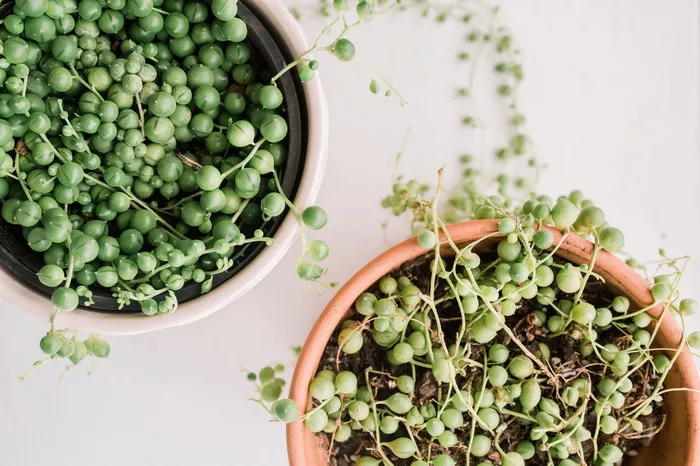Pearl succulents, scientifically known as Senecio rowleyanus, are beloved for their unique appearance resembling strings of beads. These charming plants are not only aesthetically pleasing but also relatively easy to propagate, making them a favorite among both novice and experienced succulent enthusiasts. In this comprehensive guide, we will explore various methods for propagating pearl succulents, from stem cuttings to division, ensuring successful propagation and healthy growth.
Understanding Pearl Succulents
Before delving into propagation techniques, it’s essential to understand the basic biology of pearl succulents. Native to South Africa, Senecio rowleyanus belongs to the Asteraceae family and thrives in arid environments. Its trailing stems are adorned with small, spherical leaves that store water, enabling the plant to withstand drought conditions.
Propagation is the process of producing new plants from existing ones, and pearl succulents offer several methods for achieving this. Whether you’re expanding your collection or sharing these delightful plants with friends, mastering propagation techniques is key to ensuring the continued vitality of your succulent garden.
Choosing the Right Time
Timing plays a crucial role in the success of succulent propagation. While pearl succulents can be propagated year-round, it’s generally best to undertake propagation during the plant’s active growing season, which typically occurs in spring and summer. During this time, the plant is more likely to root quickly and establish itself successfully.
Propagation Methods
1. Stem Cuttings:
Stem cuttings are one of the most popular methods for propagating pearl succulents. Follow these steps for successful stem cutting propagation:
Select a healthy stem: Choose a stem that is plump, firm, and free from signs of damage or disease.
Prepare the cutting: Using clean, sharp scissors or pruning shears, cut a section of the stem between 2 to 4 inches long. Ensure that the cutting has at least one node, where leaves are attached, as this is where roots will emerge.
Allow the cutting to callus: Place the cutting in a dry, shaded area for several days to allow the cut end to form a callus. This helps prevent rotting when the cutting is planted.
Plant the cutting: Once the cutting has calloused, plant it in a well-draining succulent mix, burying the cut end slightly into the soil. Water sparingly, allowing the soil to dry out between waterings.
Provide appropriate conditions: Place the cutting in a bright, indirect light location and maintain temperatures between 65°F to 75°F (18°C to 24°C). Avoid direct sunlight, as this can scorch the delicate leaves.
2. Leaf Cuttings:
Leaf cuttings offer another effective method for propagating pearl succulents. Follow these steps for successful leaf cutting propagation:
Select a healthy leaf: Choose a plump, healthy leaf from the mother plant, ensuring it is free from damage or signs of disease.
Remove the leaf: Gently twist the leaf from the stem, ensuring that it detaches cleanly without tearing.
Allow the leaf to callus: Place the leaf in a dry, shaded location and allow the cut end to callus for several days.
Plant the leaf: Once calloused, place the leaf on top of a well-draining succulent mix, pressing it lightly into the soil. Mist the soil lightly to moisten it.
Patience is key: Leaf propagation can be slower than stem propagation, so be patient and allow the leaf to root and produce new growth over time.
3. Division:
Division is a straightforward method of propagating pearl succulents that involves separating offsets or “pups” from the parent plant. Follow these steps for successful division propagation:
Identify offsets: Inspect the base of the mother plant for any offsets or small rosettes that have formed.
Gently remove offsets: Using clean, sharp scissors or pruning shears, carefully cut away the offsets from the mother plant, ensuring each has its own roots attached.
Plant the offsets: Plant each offset in its own container filled with well-draining succulent mix. Water lightly and provide appropriate light and temperature conditions for optimal growth.
Monitor progress: Keep an eye on the newly planted offsets and provide care as needed to promote healthy root development and growth.
Tips for Success
1. Choose the right soil: Pearl succulents thrive in well-draining soil mixtures formulated specifically for succulents and cacti. Avoid using standard potting soil, which retains too much moisture and can lead to root rot.
2. Water sparingly: Overwatering is one of the most common pitfalls when caring for succulents. Allow the soil to dry out completely between waterings, and always err on the side of underwatering rather than overwatering.
3. Provide adequate light: Pearl succulents prefer bright, indirect light. Place them near a south- or west-facing window where they can receive plenty of sunlight without being exposed to harsh midday rays.
4. Avoid extremes in temperature: While pearl succulents are resilient to fluctuating temperatures, they prefer moderate conditions. Protect them from extreme heat or cold, and avoid placing them near drafty windows or heating vents.
5. Monitor for pests and diseases: Keep a close eye on your pearl succulents for signs of pests such as aphids, mealybugs, or spider mites, as well as common diseases like root rot or powdery mildew. Promptly address any issues to prevent them from spreading to other plants.
Conclusion
Propagating pearl succulents can be a rewarding and enjoyable endeavor, allowing you to expand your collection and share the beauty of these charming plants with others. By following the techniques outlined in this guide and providing proper care and attention, you can successfully propagate pearl succulents and enjoy their unique charm for years to come. Whether you’re a seasoned succulent enthusiast or just starting your journey with these delightful plants, propagation offers a fulfilling way to connect with nature and cultivate your green thumb.


